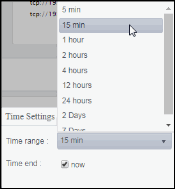IBM MQ Queues View
See performance and utilization metrics for all of your IBM MQ queue managers.
Displays in this View are:
| • | IBM MQ Queue Managers Table: This display presents a high-level perspective of utilization metrics for each IBM MQ queue managers. |
| • | IBM MQ Queues Table: This display lists all IBM MQ queues with detailed performance metrics and configuration information. |
| • | IBM MQ Queues Heatmap: This display presents a heatmap view of performance metrics and alert levels for one or all brokers. |
| • | IBM MQ Queue Summary: This display presents detailed performance metrics and configuration information for a single IBM MQ queue. |
IBM MQ Queue Managers Table
View detailed utilization metrics and parameter settings for all queue managers on a particular broker or on all brokers.
Each table row contains data for a particular queue manager. Use this display to quickly identify queue managers with performance issues and confirm configurations. Metrics include Connection Count and Max Message Length. Parameter settings such as Command Level are shown.
Use this display to quickly identify brokers with performance issues.
You can search, filter, sort and choose columns to include by clicking a column header icon (to the right of each column label) and selecting Filter, Sort Ascending, Sort Descending or Columns.
Or just click any column header to sort and compare the values that interest you. Right-click on a table cell to Export to Excel or Copy Cell Value.
Investigate a broker, its channels and queues by double-clicking a row which opens the IBM MQ Broker Summary display.
Note: This display contains vendor data. Refer to vendor documentation for details.
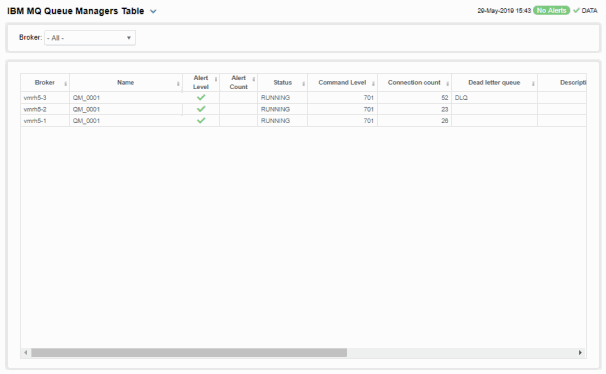
|
Filter By |
|||
|
Broker |
Select the broker for which you want to view data or select All to view data for all brokers. |
||
|
Table Each table row is a different queue manager on the selected broker. Column values describe the queue. |
|||
|
|
Broker |
The name of the broker. |
|
|
|
Name |
The name of the queue manager. |
|
|
|
Alert Level |
The current alert severity:
|
|
|
|
Alert Count |
The total number of active alerts on the queue manager. |
|
|
|
Status |
The queue manager status (for example, Running). |
|
|
|
Command Level |
The command level. |
|
|
|
Connection Count |
The number of connections on the queue manager. |
|
|
|
Dead letter queue |
The number of undelivered messages in the dead letter queue. |
|
|
|
Description |
A textual description of the queue manager. |
|
|
|
Max Message Length |
The maximum message length sent or received by the queue manager. |
|
|
|
Max priority |
The queue manager rank in priority. |
|
|
|
Platform |
The queue manager platform type. |
|
|
|
Host |
The host name. |
|
|
|
Connection |
The connection name. |
|
|
|
Expired |
When checked, performance data has not been received in the time specified in the Duration region on the RTView Configuration Application > Solution Package Configuration > IBM MQ > DATA STORAGE tab. |
|
|
|
Time Stamp |
The date and time of the last data update. |
|
IBM MQ Queues Table
View performance metrics, alert status and settings for IBM MQ queues on a particular broker or on all brokers. Metrics include total Get Messages/Put Messages, Max Q Depth and Current Q Depth. Settings such as queue Type, Host IP address and Persistence are shown.
Use this display to quickly identify queues with performance issues or capacity issues and confirm configurations.
Each row in the table contains data for a particular queue. You can search, filter, sort and choose columns to include by clicking a column header icon (to the right of each column label) and selecting Filter, Sort Ascending, Sort Descending or Columns.
Or just click any column header to sort and compare the values that interest you. Right-click on a table cell to Export to Excel or Copy Cell Value.
Investigate a queue by double-clicking a row which opens the IBM MQ Queue Summary display.
Note: This display contains vendor data. Refer to vendor documentation for details.
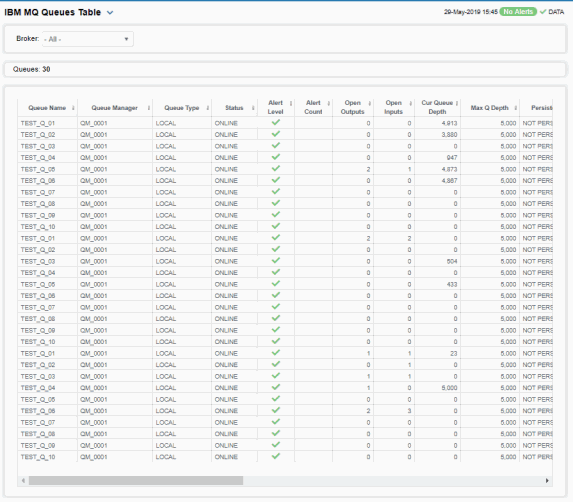
|
Filter By |
|||
|
|
MQ Broker |
Select the broker for which you want to view data or select All to view data for all brokers. |
|
|
Queues |
The number of queuse found in the query and listed inthe table. |
||
|
Table Each table row is a different queue on the selected broker. Column values describe the queue. |
|||
|
|
Broker |
The name of the broker. |
|
|
|
Queue Name |
The name of the queue. |
|
|
|
Queue Manager |
The name of the queue manager. |
|
|
|
Queue Type |
The type of queue. |
|
|
|
Status |
The queue status (for example, ONLINE). |
|
|
|
Alert Level |
The current alert severity:
|
|
|
|
Alert Count |
The total number of alerts on the queue. |
|
|
|
Open Outputs |
The number of outgoing transactions. |
|
|
|
Open Inputs |
The number of incoming transactions. |
|
|
|
Cur Queue Depth |
The current queue depth. |
|
|
|
Max Q Depth |
The maximum number of messages allowed on the queue at any one time. |
|
|
|
Persistence |
Denotes whether or not the queue manager is persistent (PERSISTENT/NOT PERSISTENT). |
|
|
|
Description |
The description of the purpose of the queue. |
|
|
|
Max Msg Length |
The maximum length of messages. |
|
|
|
Host |
The IP address of the host. |
|
|
|
Default Priority |
The default priority value for messages placed on the queue. |
|
|
|
Get Messages |
Denotes whether or not the queue enabled to get messages (GET ALLOWED/GET NOT ALLOWED). |
|
|
|
Put Messages |
Denotes whether or not the queue enabled to put messages (PUT ALLOWED/PUT NOT ALLOWED). |
|
|
|
Scope |
The defined scope setting for the queue. |
|
|
|
Shareability |
Denotes whether or not the queue is shareable (SHAREABLE/ NOT SHAREABLE). |
|
|
|
Usage |
The queue usage type (NORMAL/TRANSMISSION). |
|
|
|
Connection |
The name of the queue connection. |
|
|
|
Expired |
When checked, performance data has not been received in the time specified in the Duration region on the RTView Configuration Application > Solution Package Configuration > IBM MQ > DATA STORAGE tab. |
|
|
|
Time Stamp |
The date and time of the last data update. |
|
IBM MQ Queues Heatmap
View current alert status and performance metrics for all queues on a particular IBM MQ broker, or all queues on All brokers.
Use the Metric drop-down menu to view Alert Severity, Alert Count, Max Queue Depth, Max Message Length, Open Inputs or Open Outputs.
Each rectangle in the heatmap represents a different queue, where the rectangle color indicates the most critical alert state for items associated with that queue.
By default, the Alert Severity metric is shown. Values range from 0 - 2, as indicated in the color gradient  bar:
bar:
 (2) Red indicates that one or more metrics exceeded their ALARM LEVEL threshold.
(2) Red indicates that one or more metrics exceeded their ALARM LEVEL threshold.
 (1) Yellow indicates that one or more metrics exceeded their WARNING LEVEL threshold.
(1) Yellow indicates that one or more metrics exceeded their WARNING LEVEL threshold.
 (0) Green indicates that no metrics have exceeded their alert thresholds.
(0) Green indicates that no metrics have exceeded their alert thresholds.
Investigate a queue by clicking a rectangle which opens the IBM MQ Queue Summary display.
Mouse-over rectangles to view more details about host performance and status. Toggle between the commonly accessed Table and Heatmap displays by clicking the drop down list on the display title.
Note: This display contains vendor data. Refer to vendor documentation for details.
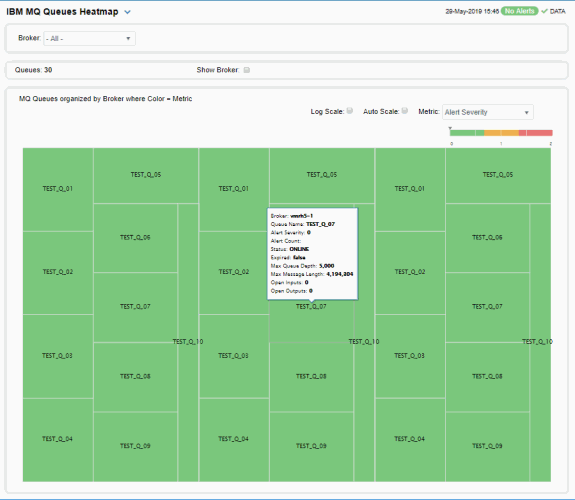
|
Filter By |
||||
|
|
Broker |
Select the broker containing the channels for which you want to view data, or select All to view all channels for all brokers. |
||
|
Fields and Data |
||||
|
|
Queues |
The number of queues found on the broker(s) and listed in the heatmap. |
||
|
|
Show Broker |
Select this check box to display the name of the broker in the heatmap. |
||
|
Heatmap |
||||
|
|
Log Scale |
Select to enable a logarithmic scale. Use Log Scale to see usage correlations for data with a wide range of values. For example, if a minority of your data is on a scale of tens, and a majority of your data is on a scale of thousands, the minority of your data is typically not visible in non-log scale graphs. Log Scale makes data on both scales visible by applying logarithmic values rather than actual values to the data. |
||
|
|
Auto Scale |
Select to enable auto-scaling. When auto-scaling is activated, the color gradient bar's maximum range displays the highest value. Note: Some metrics auto-scale automatically, even when Auto Scale is not selected. |
||
|
|
Metric |
Choose a metric to view in the display. For details about the data, refer to vendor documentation. |
||
|
|
|
Alert Severity |
The current alert severity for items associated with the rectangle. Values range from 0 - 2, as indicated in the color gradient
|
|
|
|
|
Alert Count |
The total number of critical and warning unacknowledged alerts for items associated with the rectangle. The color gradient |
|
|
|
|
Max Queue Depth |
The maximum queue depth. The color gradient |
|
|
|
|
Max Message Length |
The maximum message length. The color gradient |
|
|
|
|
Open Inputs |
The current number of open inputs. The color gradient |
|
|
|
|
Open Outputs |
The current number of open outputs. The color gradient |
|
IBM MQ Queue Summary
Investigate the performance and health of a particular IBM MQ queue. View detailed transmission metrics and settings for a single IBM MQ queue, such as Open Outputs, Queu Type and Persistence.
Track utilization and performance metrics of a queue on a particular IBM MQ broker.
Use this display to check the health of a channel and its configuration.
Choose a broker and a queue from the drop-down menus. Clicking on the information boxes at the top of the display (such as Received Buffers/second, Sent Buffers/second and Batches Completed) takes you to the IBM MQ Channels Table display, where you can sort and compare the performance values of all channels.
The trend graph traces the Activity Trends (Current Queue Depth and Oldest Message Age) rates for the selected queue. You can specify the time range for the trend graph and view data based on a log scale, which enables visualization on a logarithmic scale and should be used when the range in your data is very broad.
Or just click any column header to sort and compare the values that interest you. Right-click on a table cell to Export to Excel or Copy Cell Value.
Clicking the Critical/Warning link at the bottom of the display opens the Alerts Table by Component display. You can hover over the trend graph to see the values at a particular time.
Queu Manager, Shareability, Max Message Length, Status and Default Priority settings for the queue are also shown at the bottom of the display.
Note: This display contains vendor data. Refer to vendor documentation for details.
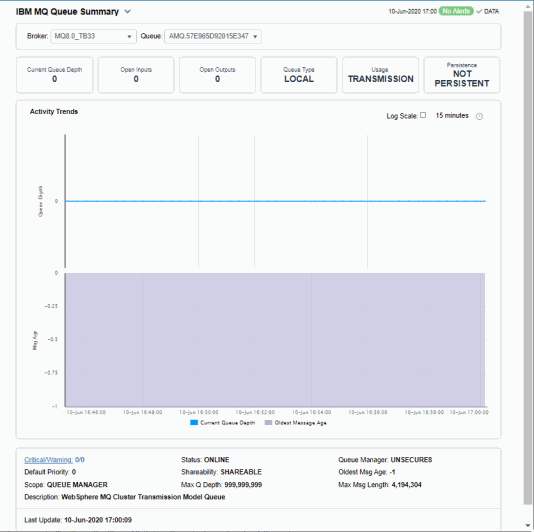
|
Filter By |
|||
|
|
MQ Broker |
Select the broker containing the queue for which you would like to view data. |
|
|
|
Queue |
Select the Queue for which you would like to view data. |
|
|
Fields and Data |
|||
|
|
Current Queue Depth |
The current depth of the queue. |
|
|
|
Open Inputs |
The total number of open inputs for the queue. |
|
|
|
Open Outputs |
The total number of open outputs for the queue. |
|
|
|
Queue Type |
The type of queue. |
|
|
|
Usage |
The queue usage type (NORMAL/TRANSMISSION). |
|
|
|
Persistence |
Denotes whether or not the queue manager is persistent (PERSISTENT/NOT PERSISTENT). |
|
|
Activity Trends Graph |
Current Queue Depth: Traces the current depth of the queue. Oldest Message Age: Traces the age of the oldest message in the queue. |
||
|
|
Log Scale |
Select to enable a logarithmic scale. Use Log Scale to see usage correlations for data with a wide range of values. For example, if a minority of your data is on a scale of tens, and a majority of your data is on a scale of thousands, the minority of your data is typically not visible in non-log scale graphs. Log Scale makes data on both scales visible by applying logarithmic values rather than actual values to the data. |
|
|
|
Time Settings |
Select a time range from the drop down menu varying from 5 Minutes to Last 7 Days. By default, the time range end point is the current time.
To change the time range, deselect the now toggle, which displays some additional date fields. You can click the left and right arrow buttons to decrease the end time by one time period (the time selected in the Time range drop down) per click, or you can choose the date and time from the associated calendar and clock icons. You can also enter the date and time in the text field using the following format: MMM dd, YYYY HH:MM:ss. For example, Aug 21, 2018 12:24 PM. Click the now toggle to reset the time range end point to the current time.
|
|
|
Critical/Warning |
The total number of critical and warning alerts. |
||
|
Shareability |
Denotes whether or not the queue manager is shareable (SHAREABLE/NOT SHAREABLE). |
||
|
Max Q Depth |
The maximum number of messages allowed on the queue. |
||
|
Description |
The description of the queue. |
||
|
Status |
The status of the queue. |
||
|
Oldest Msg Age |
The age of the oldest message in the queue. |
||
|
Max Msg Length |
The maximum message length on the queue. |
||
|
Default Priority |
The default priority setting on the queue manager. |
||
|
Scope |
The defined scope for the queue. |
||
|
Last Update |
The data and time of the last data update. |
||











 bar, populated by the current heatmap, shows the value/color mapping. The numerical values in the gradient bar range from 0 to the defined Alert Level for the
bar, populated by the current heatmap, shows the value/color mapping. The numerical values in the gradient bar range from 0 to the defined Alert Level for the  bar, populated by the current heatmap, shows the value/color mapping. The numerical values in the gradient bar range from 0 to the maximum message length in the heatmap. The middle value in the gradient bar indicates the middle value of the range.
bar, populated by the current heatmap, shows the value/color mapping. The numerical values in the gradient bar range from 0 to the maximum message length in the heatmap. The middle value in the gradient bar indicates the middle value of the range. bar, populated by the current heatmap, shows the value/color mapping. The numerical values in the gradient bar range from 0 to the maximum number of open inputs in the heatmap. The middle value in the gradient bar indicates the middle value of the range.
bar, populated by the current heatmap, shows the value/color mapping. The numerical values in the gradient bar range from 0 to the maximum number of open inputs in the heatmap. The middle value in the gradient bar indicates the middle value of the range. bar, populated by the current heatmap, shows the value/color mapping. The numerical values in the gradient bar range from 0 to the maximum number of open outputs in the heatmap. The middle value in the gradient bar indicates the middle value of the range.
bar, populated by the current heatmap, shows the value/color mapping. The numerical values in the gradient bar range from 0 to the maximum number of open outputs in the heatmap. The middle value in the gradient bar indicates the middle value of the range.